Full Body Workout at Home: Sculpt, Strengthen & Burn Fat Without Equipment Plus Keto-Friendly Tips
This post may contain affiliate links. If you purchase through these links, I may earn a small commission at no extra cost to you. LEARN MORE.
It is possible to sculpt muscle, build strength, and burn fat using just your bodyweight at home.
Anyone can start an effective full body workout in their living room—no equipment or gym membership required.
These routines can improve strength, coordination, and balance while helping support long-term weight management.
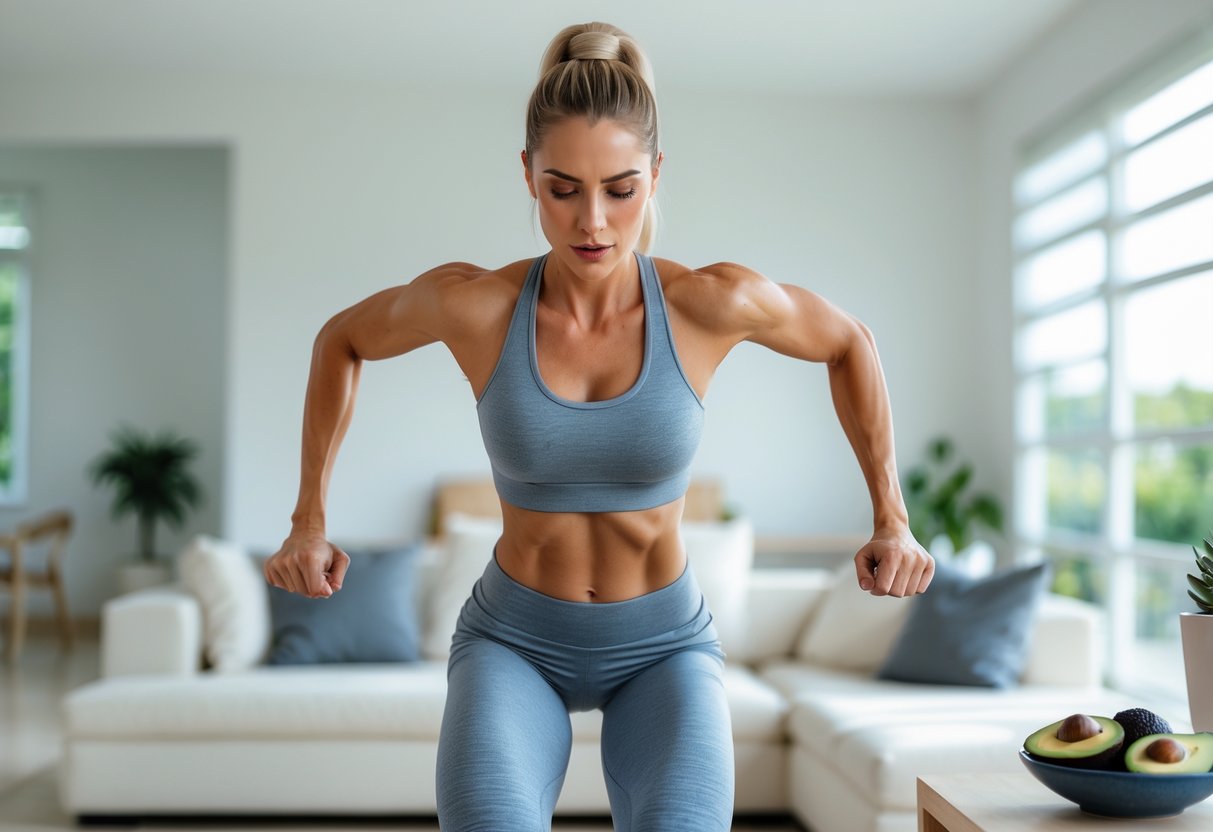
For those looking to maximize results, combining exercise with simple keto-friendly nutrition tips provides extra support for reaching fitness goals. Explore the benefits of exercising on a keto diet.
This approach makes workouts manageable and sustainable for all experience levels, whether someone is a beginner or already active.
Want faster fat-burning results? Try the Custom Keto Diet Plan tailored to your lifestyle and workout goals.”
Key Takeaways
- Full body workouts at home use bodyweight to build strength and burn fat.
- Effective plans improve muscle tone, balance, and motivation over time.
- Keto-friendly nutrition tips can help support fitness results.
Benefits of a Full Body Workout at Home
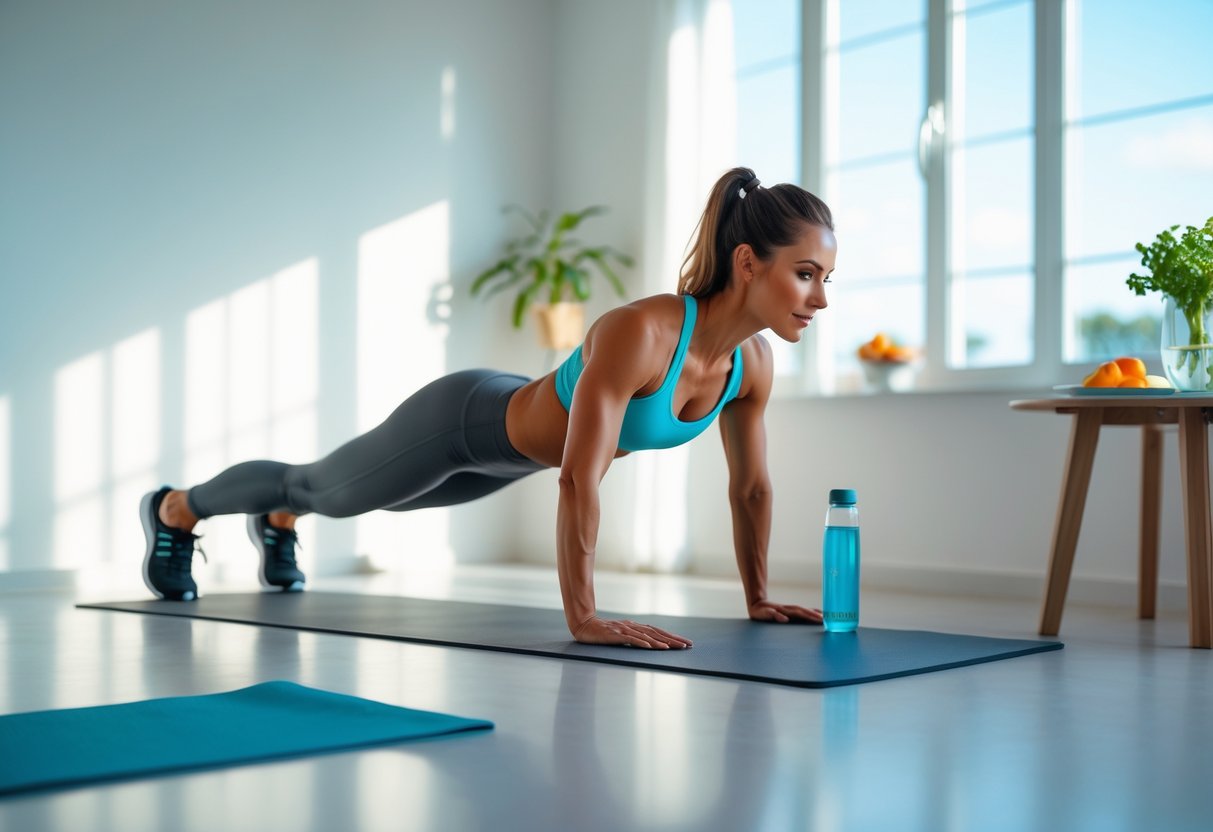
A full-body workout at home builds total body strength, increases stamina, and helps burn fat efficiently.
Combining bodyweight movements boosts flexibility and coordination, which supports daily activities and long-term health.
Improved Strength and Endurance
Full-body workout at home use compound exercises that work several muscle groups at once.
This approach develops both muscle strength and stamina over time.
Squats, push-ups, and lunges are some examples.
These moves don’t need any equipment, making them easy to do at home.
Consistent practice leads to stronger muscles and joints, better posture, and a natural boost in everyday energy.
A routine focusing on whole body movements keeps the workout challenging.
People often notice improved grip strength, core stability, and greater ease handling physical tasks.
Home workouts can significantly improve your strength, especially when you follow structured routines like these leg-focused home workouts for strength and fat loss.
Enhanced Flexibility and Balance
Home workouts that target the whole body also improve flexibility and balance by including a range of motion exercises.
Movements like planks, bridges, and dynamic stretches make muscles more elastic and help joints move smoothly.
Greater flexibility lowers the risk of injuries by keeping muscles and tendons healthy.
Balance exercises like single-leg stands or split squats train the body to stay steady and prevent falls.
These improvements make it easier to do daily tasks, exercise safely, and maintain strong mobility as people age.
Flexibility and balance gained from full-body workouts also support other sports and fitness activities.
Incorporating shoulder mobility drills, such as those shared in our no-equipment shoulder workout guide, improves posture and functional balance.
Fat-Burning and Muscle Sculpting
Full-body workouts are efficient for burning calories because they engage major muscle groups at the same time.
This leads to a higher heart rate and increased energy use compared to isolated exercises.
Bodyweight circuits—like burpees, mountain climbers, and jumping jacks—raise the metabolism during and after the workout.
Combining strength and cardio in one session helps the body burn fat, while routines like these also shape and tone muscles across the arms, legs, and core.
Essential Preparation Before You Start
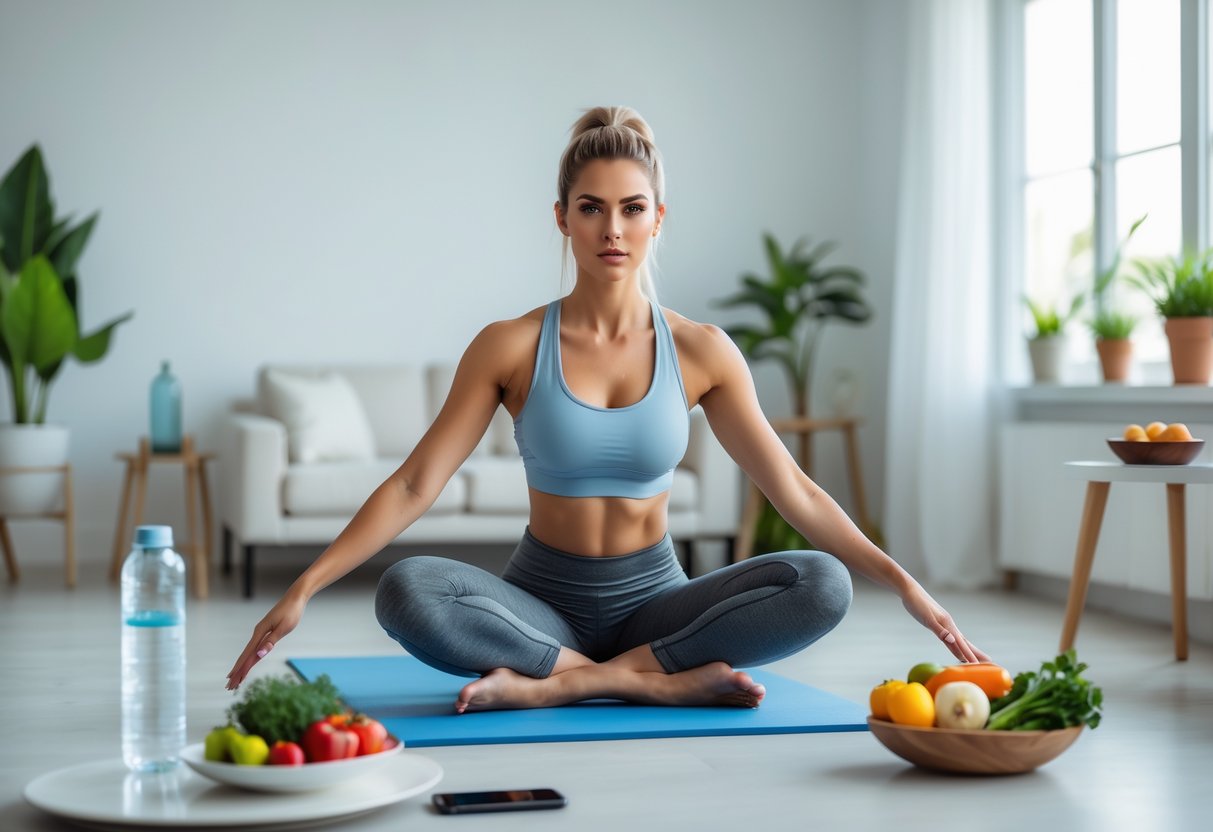
Creating the right environment and having the correct tools can make home workouts more effective.
Good preparation helps reduce risk of injury, supports body alignment, and builds more consistent habits.
Choosing the Right Space
Pick an area with enough room to move freely in all directions.
Hardwood, tile, or carpeted floors can work, but using an exercise mat or yoga mat is best to reduce impact and protect joints.
Look for a spot with good ventilation and natural light if possible.
This helps keep energy levels up and improves mood.
Remove clutter or anything that could cause you to trip or slip.
Shoes with a flat sole are optional but can help with balance for some exercises.
If space is tight, focus on movement patterns that don’t require much travel, like squats, push-ups, and planks.
Recommended Equipment and Alternatives
Most no-equipment routines use bodyweight, but a few basic items can add comfort:
| Item | Benefits | Alternatives |
|---|---|---|
| Yoga/Exercise Mat | Cushions knees, supports joints | Towel, carpet |
| Water Bottle | Hydration | Any clean container |
| Timer/Stopwatch | Helps track intervals | Phone, kitchen timer |
If extra resistance is wanted, household items (water bottles, backpacks with books) can substitute for dumbbells.
Wear clothes that allow easy movement and help wick sweat.
Optional extras, like resistance bands, provide more challenge, but are not necessary.
Warming Up Effectively
Start every workout with a short warm-up routine to prepare muscles and joints.
This should raise heart rate and loosen up major muscle groups.
Good choices include arm circles, marching in place, high knees, or gentle jumping jacks.
Aim for 5-10 minutes, making sure to include dynamic stretches (like leg swings or torso twists) instead of static stretching.
Focus on body alignment during the warm-up.
Stand tall, keep the core engaged, and move with control.
This sets up proper form and reduces risk of strain once the workout begins.
Support your metabolism naturally with Java Burn—a tasteless powder that boosts fat burn when mixed with your morning coffee.
Bodyweight Exercises for Total Body Sculpting
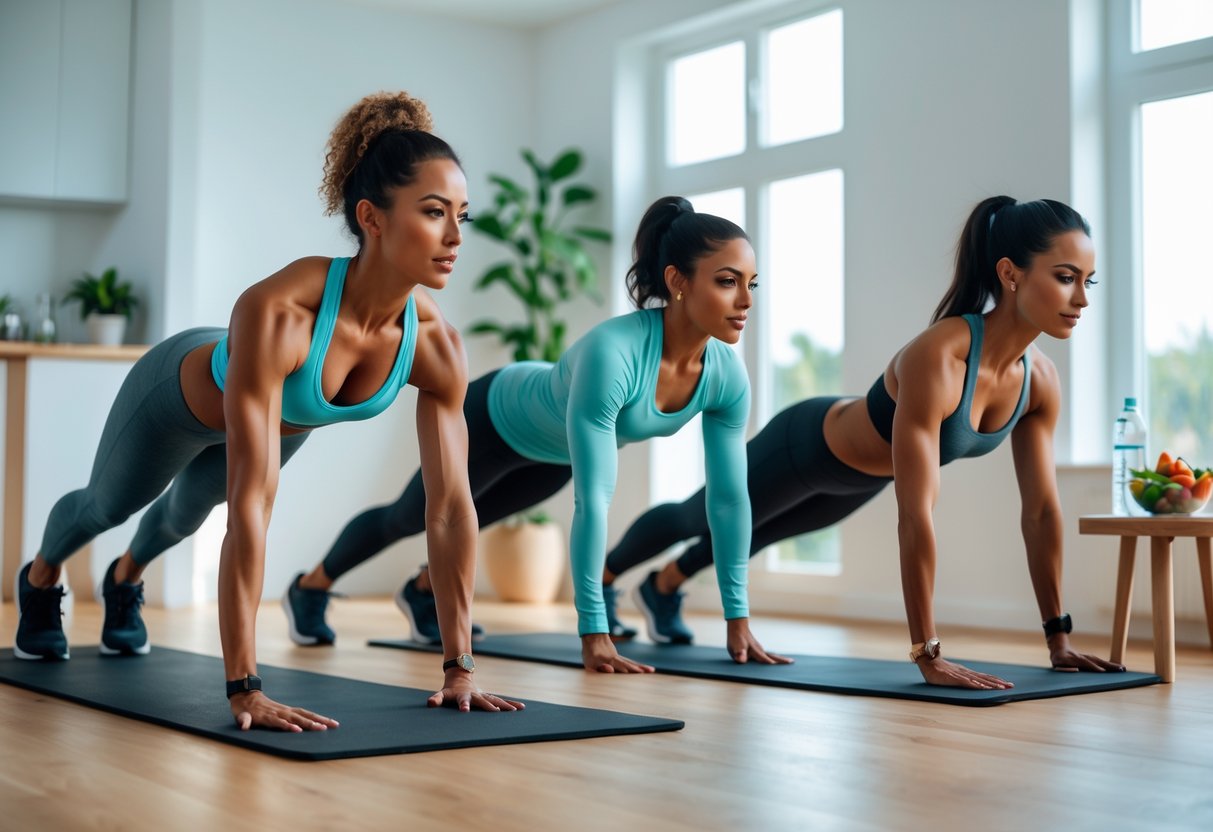
Bodyweight exercises use a person’s own weight to build strength, stability, and muscle tone.
They can target all major muscle groups and require no equipment, making them ideal for home workouts.
Lower Body: Squats, Lunges, and Variations
Squats and lunges are standard bodyweight moves for building strong legs, glutes, and core.
Squats target the thighs (quadriceps), hamstrings, and glute muscles.
Beginners can start with bodyweight squats and progress to split squats or jump squats to increase intensity.
Try this basic sequence:
- Standard Squat: Feet shoulder-width apart, lower down as if sitting in a chair.
- Split Squat: One foot forward, one back, lower your body straight down.
- Reverse Lunge: Step one foot back, bend both knees, return to start.
Adding jump squats or jump lunges can increase heart rate and help burn more calories.
These foundational movements can be modified for beginners or intensified with pulses and holds. Pair them with recipes from our lazy keto meal plan to stay energized without cooking fatigue.
Upper Body: Push-Ups and Alternatives
Push-ups focus on the chest, arms, and shoulders while also working the core.
They can be modified for all fitness levels.
Beginners may perform knee push-ups, while advanced individuals can try decline or diamond push-ups.
- Standard Push-Up: Hands below shoulders, body straight, lower down and push up.
- Knee Push-Up: Same as above, but with knees on the ground.
- Incline Push-Up: Hands on an elevated surface, easier on shoulders.
For more variety, tricep dips (using a sturdy chair or step) can add another level of challenge for the arms.
For sculpted arms, explore variations in our at-home arm workout guide for women.
Core Training: Planks and Bridges
A strong core helps with balance and stability.
Planks are a versatile exercise that works the abdominal muscles, back, and shoulders.
Forearm planks and side planks are popular choices.
- Forearm Plank: Elbows under shoulders, hold body straight like a plank.
- Side Plank: Lie on one side, prop up on elbow, stack feet, hold body straight.
Glute bridges target the glutes, lower back, and hamstrings.
Lay on your back, feet flat, and lift hips up, squeezing the glutes at the top.
For extra challenge, try single-leg glute bridges.
These movements support posture, protect the lower back, and boost overall strength for daily activities.
Planks activate your core stabilizers—consider adding side planks as shown in our core-strengthening program for beginners.
Targeting Key Muscle Groups
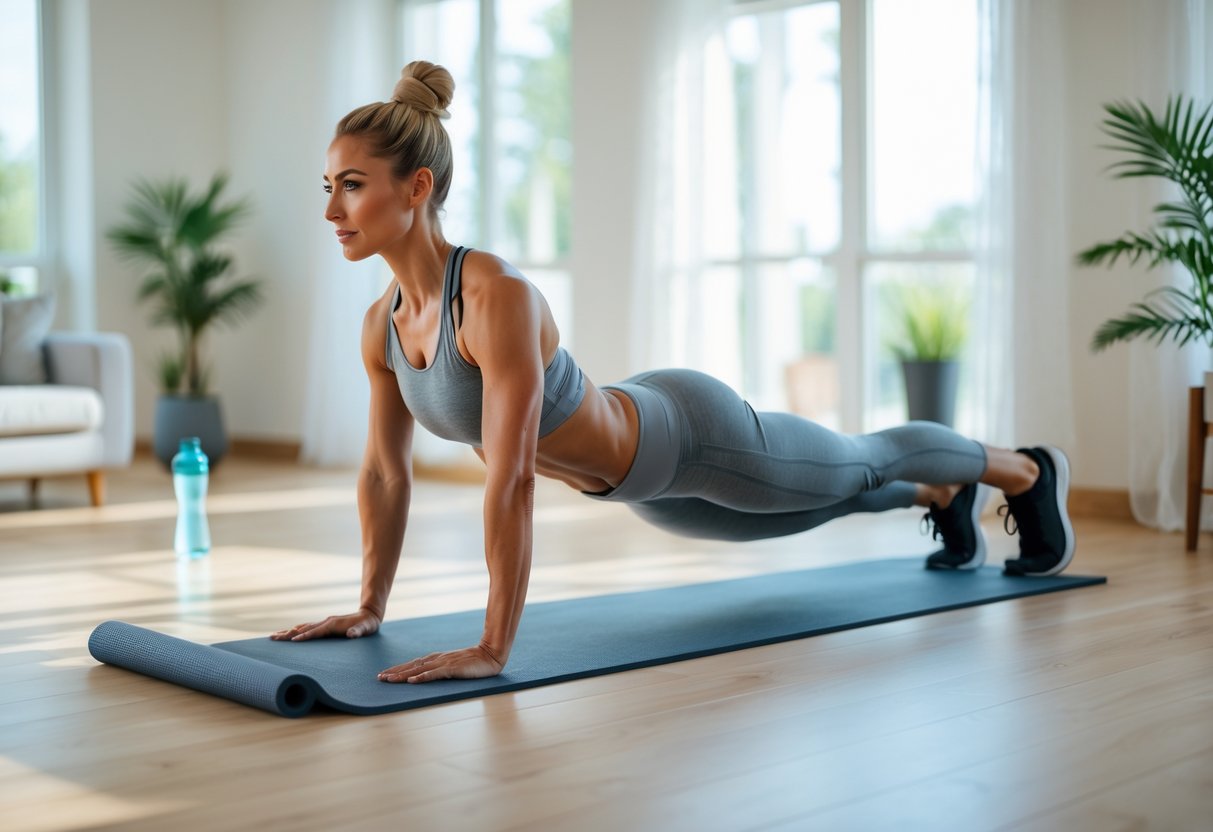
A full body workout at home uses simple moves that work several muscle groups at once.
Focusing on lower body, upper body, and core can help build muscle, increase strength, and improve balance without any equipment.
Lower Body Activation
Lower body exercises are important because they work large muscle groups.
These include the quadriceps, hamstrings, glutes, and calves.
Moves such as squats, lunges, and glute bridges use the legs and hips to build strength.
They also help with balance and make daily tasks, like walking or climbing stairs, easier.
Proper muscle activation is key for these moves.
For example, focusing on squeezing the glutes at the top of a squat or bridge can help target the right muscles.
Holding a plank with a mini squat or step-up can also work both the legs and core.
For best results, slow down the movement and use good form.
This reduces the risk of injury and makes sure the right muscles are working.
Sample Lower Body Exercises:
| Exercise | Main Muscles Worked | Tips |
|---|---|---|
| Squat | Quads, glutes, hamstrings | Keep chest up and knees behind toes |
| Lunge | Glutes, hamstrings | Step forward and lower knee slowly |
| Glute Bridge | Glutes, hamstrings, core | Squeeze glutes at the top, keep feet flat |
Upper Body Engagement
The upper body includes the chest, back, shoulders, and arms.
Bodyweight exercises, like push-ups, dips (using a chair), and plank shoulder taps, build strength and muscle without any equipment.
Proper form is important to activate the right muscles and prevent strain on the wrists and lower back.
Push-ups should keep the elbows close to the body, and hands under the shoulders.
Different angles, such as incline push-ups or wide push-ups, work more muscle groups.
Exercises like supermans and reverse flys target the upper and lower back.
These moves help with posture and can reduce the risk of back pain.
Mixing push and pull movements ensures the workout is well balanced.
Sample Upper Body Exercises:
- Push-Ups
- Triceps Dips (on a stable chair)
- Plank Shoulder Taps
- Supermans (lying face down, lifting arms and legs)
Core and Stability Focus
The core includes the abdominals, lower back, and hips. Core strength and stability are needed for almost every movement in daily life and exercise.
Bodyweight moves like planks, side planks, and dead bugs keep the midsection strong and protect the lower back. A strong core supports good posture and helps with balance.
Engaging the core during most exercises can make the entire workout more effective. Stability moves, such as single-leg stands or bird dogs, challenge balance and build control in small stabilizer muscles.
When doing core exercises, it’s important to focus on steady breathing and tight form. Avoid letting the back sag or arch too much.
Sample Core Moves:
- Plank (hold for 15–45 seconds)
- Side Plank
- Bird Dog
- Dead Bug
For better posture and spinal alignment, follow routines in our beginner strength training plan for women which integrates core work.
Fat-Burning Strategies Without Equipment
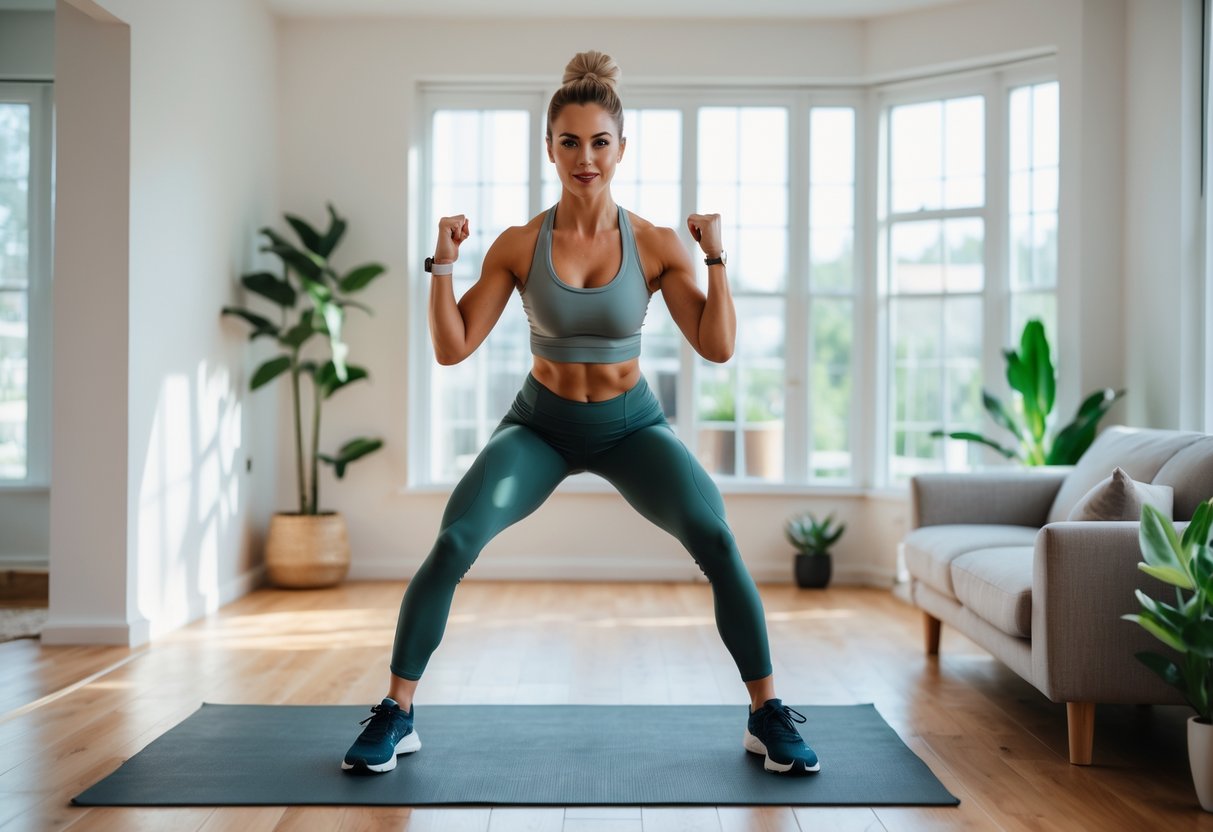
Burning fat at home is possible with the right approach. Using bodyweight exercises, short bursts of intense effort, and safe cardio moves, anyone can build strength and boost fat-burning without special gear.
High-Intensity Interval Training (HIIT)
HIIT combines short, intense bursts of activity with brief recovery periods. Exercises like jumping jacks, high knees, or mountain climbers can be done at a fast pace for 20–40 seconds.
Resting for 10–20 seconds allows the body to catch up before the next round starts. This type of workout keeps the heart rate elevated.
A higher heart rate means more calories and fat are burned in less time compared to steady-paced exercise. It also improves cardiovascular fitness and works most of the major muscles.
A sample HIIT circuit might look like:
| Exercise | Duration | Rest |
|---|---|---|
| Jumping Jacks | 30 sec | 15 sec |
| High Knees | 30 sec | 15 sec |
| Mountain Climbers | 30 sec | 15 sec |
| Squats | 30 sec | 15 sec |
Repeat this circuit 3–4 times for a full workout.
Combine HIIT circuits with intermittent fasting for greater results—see how in our article on keto and intermittent fasting for fat loss.
Effective Cardio Moves at Home
Bodyweight cardio exercises are simple but target many muscle groups and keep the body moving. Classic moves include high knees, burpees, and jumping lunges.
These exercises can be mixed into any routine for better fat-burning.
A quick list of no-equipment cardio exercises:
- High Knees: March or run in place, lifting each knee above hip level for extra effort.
- Burpees: A combination of a squat, plank, and jump.
- Jumping Jacks: Raise the heart rate quickly using full-body movements.
- Mountain Climbers: Engage the core while boosting heart rate and endurance.
Rotating through these moves in intervals prevents boredom and challenges different muscles.
Elevating Heart Rate Safely
Maintaining an elevated heart rate is key for burning fat but it must be done safely. Start with a gentle warm-up to prepare muscles and joints.
Gradually increase intensity, especially for those new to high-intensity or interval training. They should listen to their body and rest if dizzy or overly fatigued.
Good form comes before speed to avoid injury. It’s also smart to include cool-down stretches at the end to help the heart rate return to normal and reduce muscle soreness.
Choosing low-impact alternatives, like step touches or marching, is helpful for beginners or those with joint concerns. This approach keeps fat-burning efficient and exercise safe for everyone.
Enhance daily calorie burn and reduce bloating with Nagano Tonic, a Japanese-inspired fat-burning drink infused with natural herbs.
Structuring an Effective Home Workout Plan
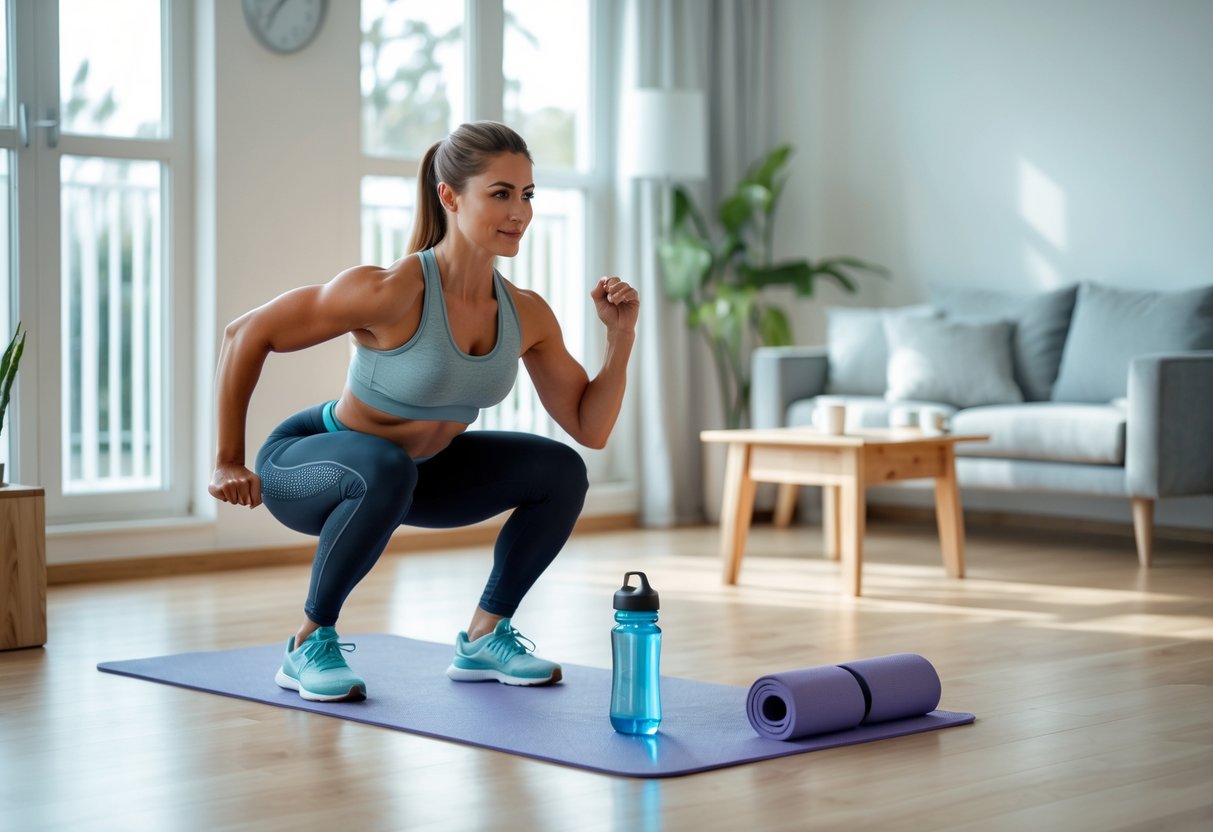
An effective home workout plan covers the whole body, uses a clear schedule, adapts to different fitness levels, and helps prevent burnout or boredom. It should focus on mixing up exercises, setting a routine, and making time for rest.
Weekly Routines and Scheduling
A well-structured plan often involves 3 to 5 workout days per week. Beginners may start with 2 to 3 days, while more advanced individuals train up to 5 days.
A sample weekly routine might look like this:
| Day | Focus |
|---|---|
| Monday | Full Body Workout |
| Tuesday | Rest or Active Recovery |
| Wednesday | Full Body Workout |
| Thursday | Cardio or Mobility |
| Friday | Full Body Workout |
| Saturday | Rest or Light Movement |
| Sunday | Rest |
Each session should combine upper body, lower body, and core moves. Spread workouts across the week to help the body recover while still building strength and endurance.
Need more ready-to-go routine? Use our Full Body Workout Routine for structured results.
Progressions and Variations
Progression keeps each full body workout challenging and avoids plateaus. To progress, increase reps, shorten rest times, or try tougher variations like single-leg squats or decline push-ups.
Vary exercises every 2-4 weeks. For example, swap regular squats for jump squats or push-ups for diamond push-ups.
This keeps muscles guessing and helps develop different movement skills. Add isometric holds such as plank variations and tempo changes for more challenge.
These methods work for all fitness levels by allowing easy or advanced options.
Balancing Intensity and Recovery
Intensity and recovery must be balanced to prevent injury and support growth. High-intensity sessions can lead to muscle fatigue, so rest is vital.
Listen to the body’s signals. Schedule at least one full rest day per week.
Active recovery, like stretching or walking, helps keep muscles loose between sessions. A simple way to adjust intensity is changing exercise order, performing circuits, or limiting rest between sets.
Beginner and advanced levels should both monitor how they feel and make changes as needed to avoid overtraining.
Improving Balance, Coordination, and Mobility
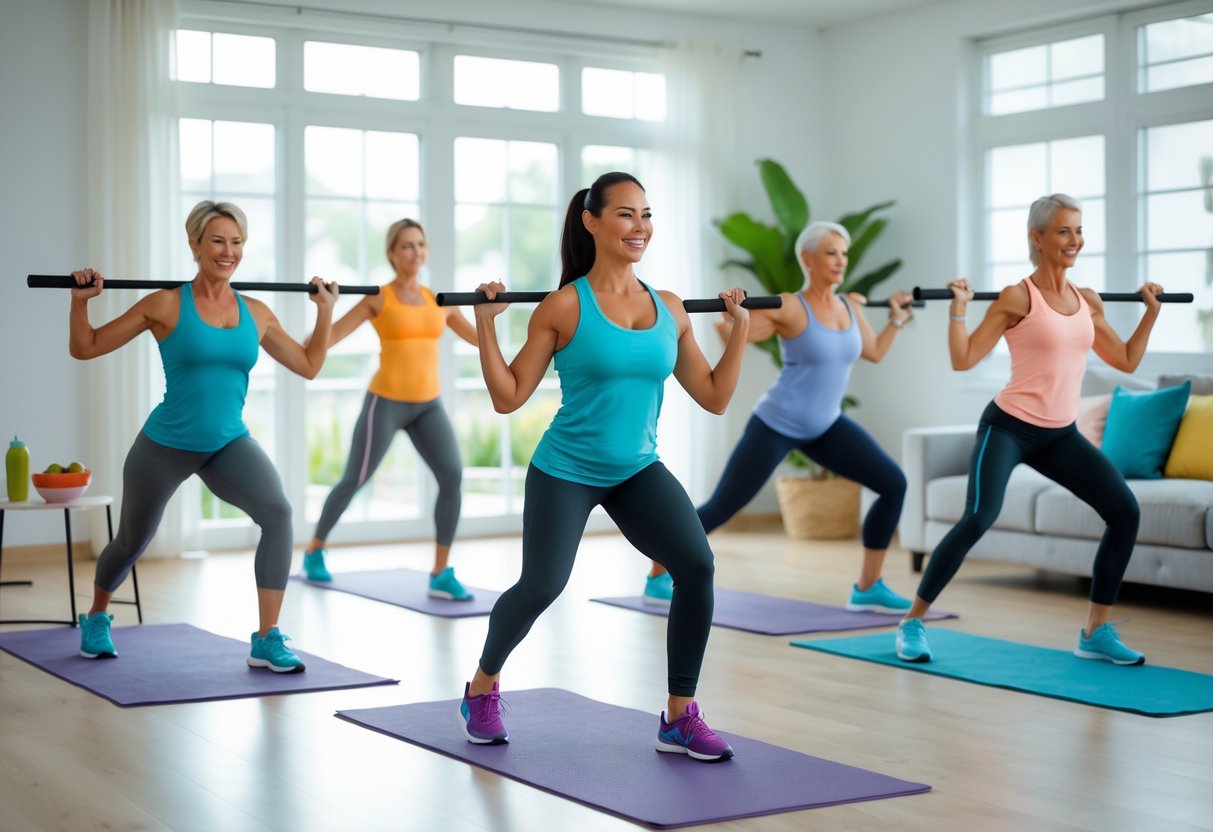
Balance, coordination, and mobility allow people to move safely and effectively at home. Strengthening these skills can also reduce the risk of injury and help with general movement control.
Dynamic Stability Techniques
Dynamic stability focuses on holding proper body alignment during movement. Exercises like single-leg stands, walking lunges, and lateral leg raises help improve the ability to stay balanced in everyday activities.
Practicing these moves engages the core, hips, and ankles. Try holding each single-leg stand for 20-30 seconds per side.
Adding arm movements while balancing on one foot makes it harder, boosting stability over time. Balance walks, such as heel-to-toe walking in a straight line, can be done along a hallway or with masking tape on the floor.
Soft surfaces, like a folded towel, add a challenge for deeper control. Focus on standing tall, shoulders back, and eyes forward during each exercise.
Training balance three to five times per week is usually enough for steady results.
Coordination Drills
Coordination drills teach muscle groups to work together, making everyday tasks easier. Simple drills that use both sides of the body or cross the midline of the body are especially helpful.
Exercises include alternating step touches, grapevine steps, or marching in place while tapping the opposite hand to knee. These drills activate the brain and body together, which sharpens coordination.
Practicing side shuffles, jumping jacks, and shadow boxing also challenges timing and rhythm. A basic ladder drill—drawing squares with tape on the floor and stepping in and out—can be done at home to boost foot coordination.
Stick with slow, controlled movements first, then speed up as skills improve. This careful approach helps prevent injury and develops more reliable movement patterns.
Adapting Workouts for All Fitness Levels
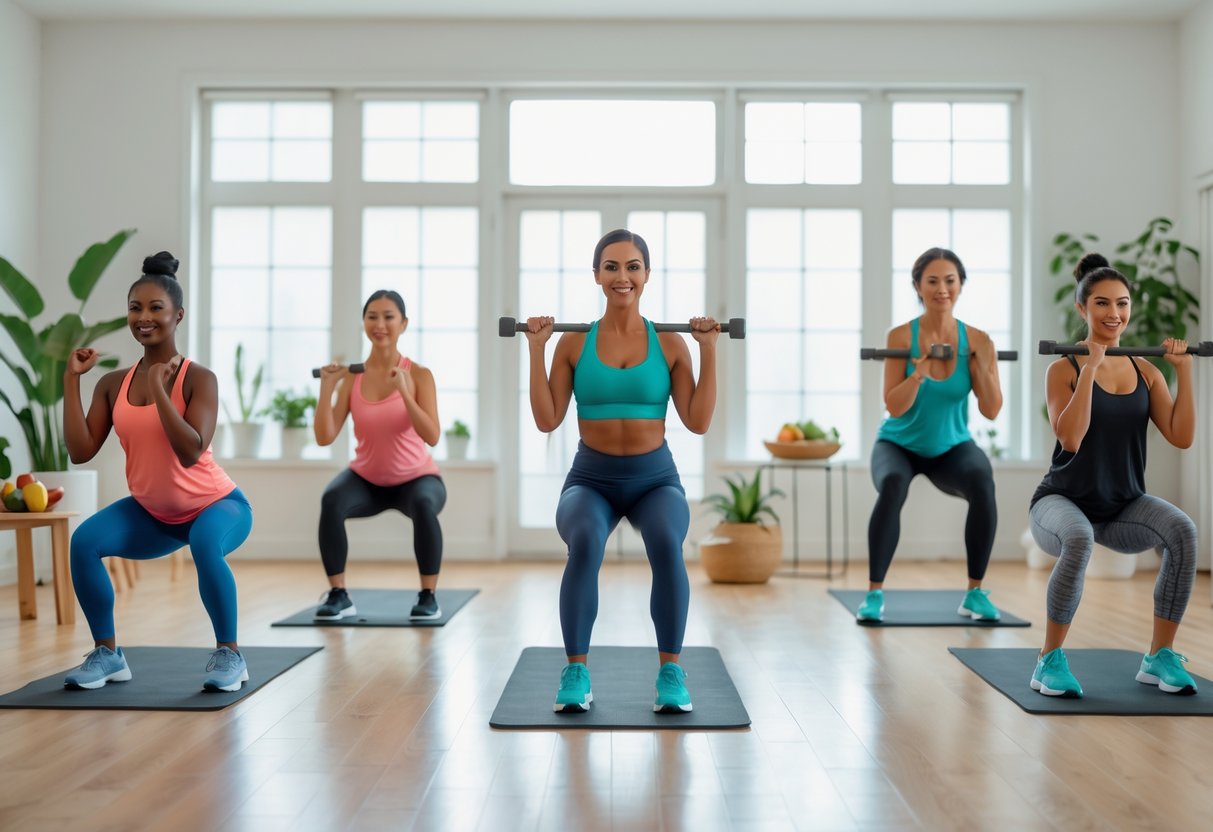
Not everyone is starting from the same place, so it’s important to adjust full body workouts for different abilities. Small changes in form or intensity can help beginners build confidence and allow advanced exercisers to push harder.
Beginner Modifications
Beginners should focus on form and consistency before adding intensity. Starting with simple movements like wall push-ups, bodyweight squats, and gentle lunges reduces injury risk.
Try these beginner tips:
- Do push-ups with knees on the ground
- Hold a plank from the knees
- Use a stable chair for step-ups
- Perform squats to a chair instead of full depth
Shorter workouts, such as 15–20 minutes, may be better for those just starting. Rest longer between sets, usually 60–90 seconds.
Following along with a fitness trainer’s online video or app can help with motivation and provide clear instructions. Focus on proper breathing with each move.
It helps reduce fatigue and keeps the body in sync.
For newcomers, follow our step-by-step beginner workout guide at home that ensures steady, injury-free progress.
Advanced Progressions
Advanced levels should increase intensity and complexity. This can mean adding pulsing squats, plyometric lunges, burpees, or single-leg exercises.
Decreasing rest periods (30 seconds or less) also raises the challenge. Combine moves into circuits for higher intensity:
| Move | Reps |
|---|---|
| Jump Squats | 15 |
| Push-Ups | 20 |
| Mountain Climbers | 30 sec |
| Plank | 60 sec |
Adding tempo changes (such as slow descents and quick rises) taxes muscles even more.
Fitness trainers recommend rotating exercises weekly to avoid plateaus and keep motivation high. Tracking reps, sets, and time helps monitor progress and set goals.
Advanced users can also try AMRAP (as many rounds as possible) routines for extra challenge.
Keto-Friendly Tips to Support Your Fitness Goals
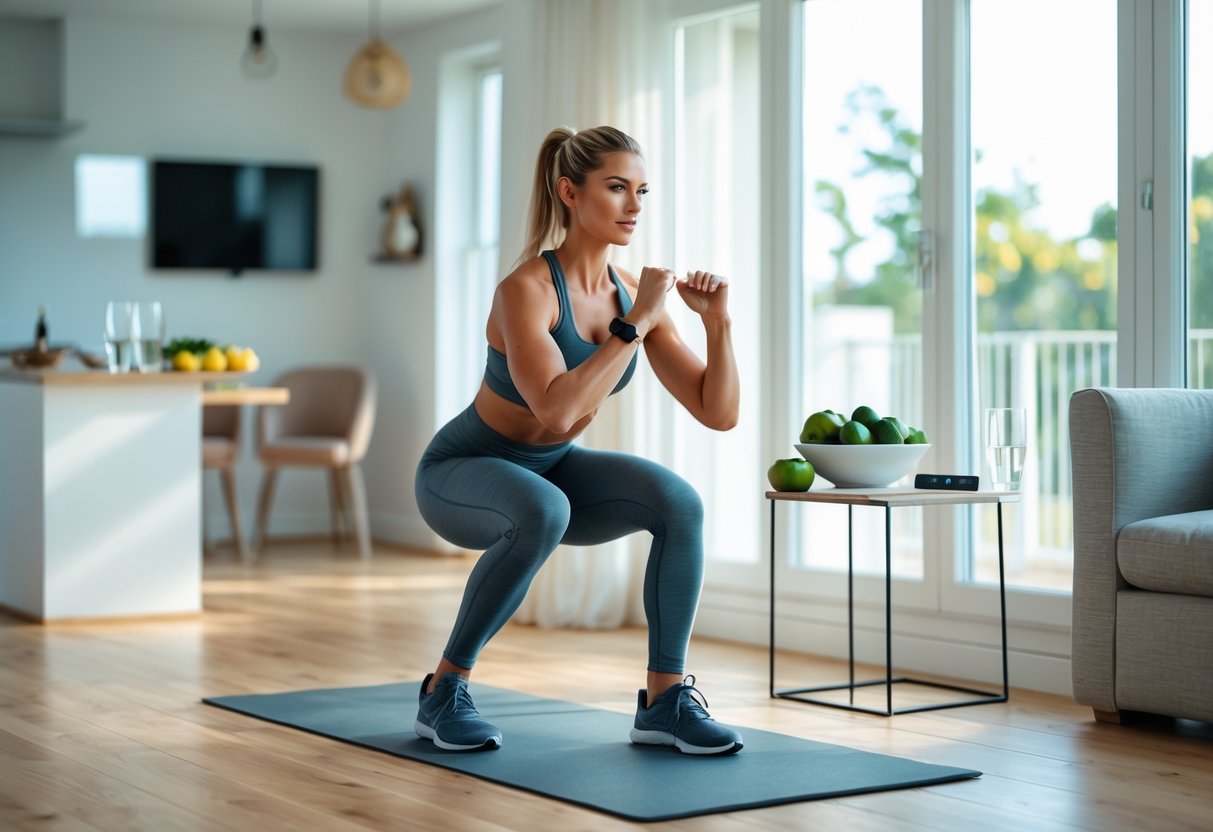
A ketogenic diet can aid fat loss and support muscle maintenance. Simple strategies with nutrition, meal planning, hydration, and recovery are key for seeing results and feeling good during home workouts.
Basics of the Keto Diet
The keto diet is a low-carb, high-fat eating plan. It shifts the body’s main energy source from carbs to fat, creating a state called ketosis.
This means the body burns stored fat for energy instead of glucose.
People often start keto by keeping daily carbs below 50 grams. The rest of their calories come mainly from healthy fats like avocado, olive oil, and nuts, along with moderate protein from sources such as eggs or chicken.
Plants like leafy greens are also encouraged due to their lower carb content and added fiber.
Because the body must adjust to burning fat for fuel, starting keto can affect energy and workout performance for the first couple of weeks. It’s important to listen to the body and not push too hard during this time.
Signs like tiredness or brain fog are common but usually pass as the body adapts.
If you’re new to keto, read our beginner’s guide to starting keto safely and effectively.
Meal Planning for Optimal Results
A weekly meal plan can help keep macros balanced and prevent unwanted carb intake. Including lean proteins, healthy fats, and lots of low-carb vegetables makes it easier to meet nutritional needs.
Here’s a simple guide for building a keto meal:
- Fill half your plate with non-starchy veggies (like spinach, broccoli, or zucchini).
- Add a palm-sized serving of protein (such as grilled chicken or tofu).
- Finish with a source of fat (like a handful of olives or sliced avocado).
Precooked meals and snacks are useful for busy days. Keto-friendly snack ideas include boiled eggs, cheese sticks, or mixed nuts.
Tracking food intake using a notebook or app can help stick to daily goals.
Get a ready-to-follow 7-day meal plan with grocery lists and recipes—designed for weight loss and performance. Start the Custom Keto Diet today!
Hydration and Recovery Strategies
Staying hydrated is crucial on keto. The body loses more water and electrolytes due to lower carb consumption, so it helps to drink extra water daily.
Adding sources of salt, potassium, and magnesium—like lightly salted nuts, leafy greens, or a small pinch of sea salt in water—can help prevent muscle cramps and fatigue.
Some people use electrolyte supplements, especially if they sweat a lot during workouts.
Rest is important to help muscles recover, especially during the first weeks on keto. Sleeping at least 7–8 hours a night, stretching, and taking occasional rest days help with recovery and maintain workout performance.
Tracking Progress and Staying Motivated
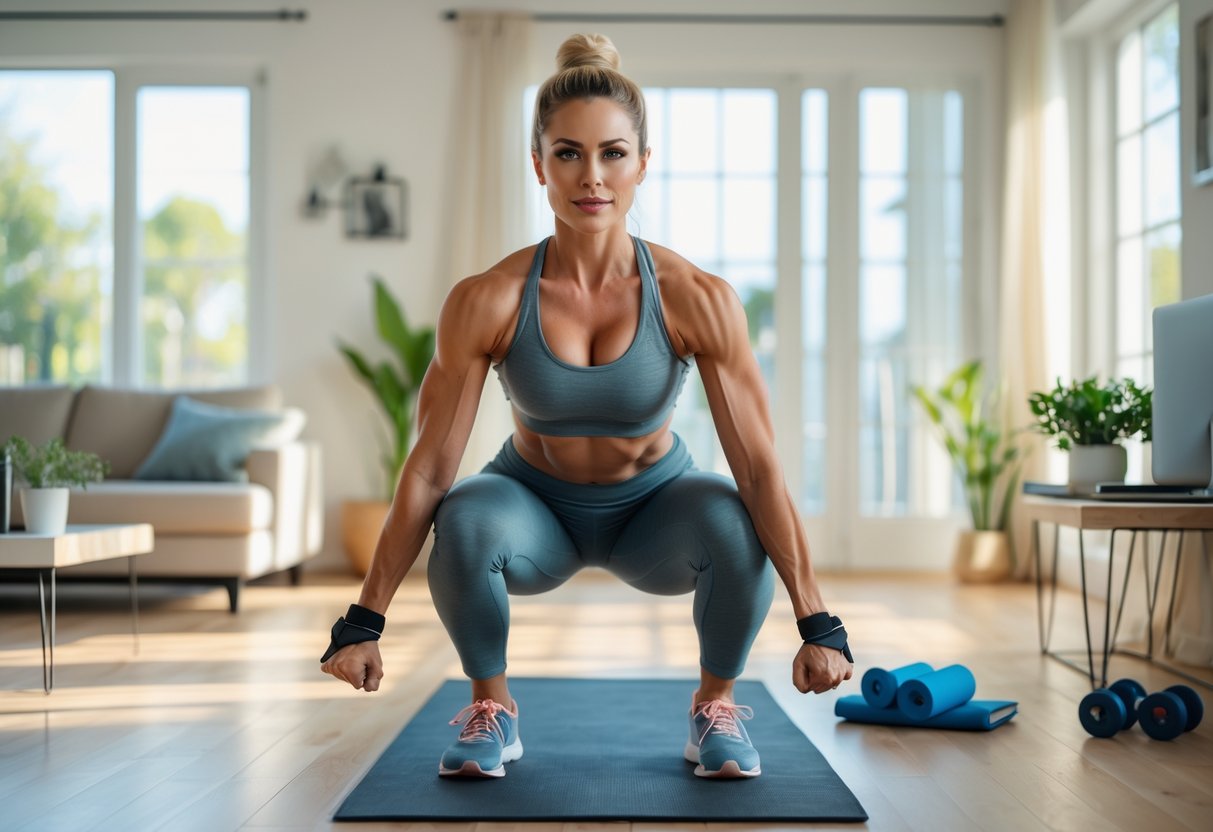
Tracking results and staying motivated help keep people on task with their fitness routine. By measuring changes and setting realistic goals, it becomes easier to stick to a workout and make steady improvements.
Measuring Physical Improvements
One of the simplest ways to measure physical improvement is by recording repetitions, time, and the number of sets completed for each exercise. Using a notebook, phone app, or even a piece of paper, individuals can log each workout.
Regular tracking lets people see patterns and small changes over time, such as being able to do more push-ups or holding a plank longer.
Some may also track weight, body measurements, or how their clothes fit for a more complete view of progress.
Wearable devices like fitness trackers and smartwatches can help monitor steps, heart rate, and calories burned. These devices provide easy-to-read data and make it possible to see improvements in daily activity levels.
Even simple photos taken every few weeks can help show visible changes in muscle tone over time.
Setting Achievable Goals
Setting clear and achievable goals is important for long-term motivation. Goals should be specific, measurable, and focused on what can be controlled—like doing a 30-minute workout three times a week or holding a plank for 60 seconds.
Breaking larger goals into smaller steps makes progress feel more manageable. For example, instead of aiming to “get fit,” a person might set a goal to complete five no-equipment workouts in one week.
Crossing off small goals can boost confidence and keep motivation high.
It also helps to write down goals and keep them somewhere visible. Reviewing these goals often allows for adjustments as needed and provides reminders of how far a person has come.
If motivation fades, revisiting why they started the routine in the first place can help renew focus.
If your fat loss stalls, revisit our guide on how to overcome keto plateaus with strategic adjustments.
Frequently Asked Questions
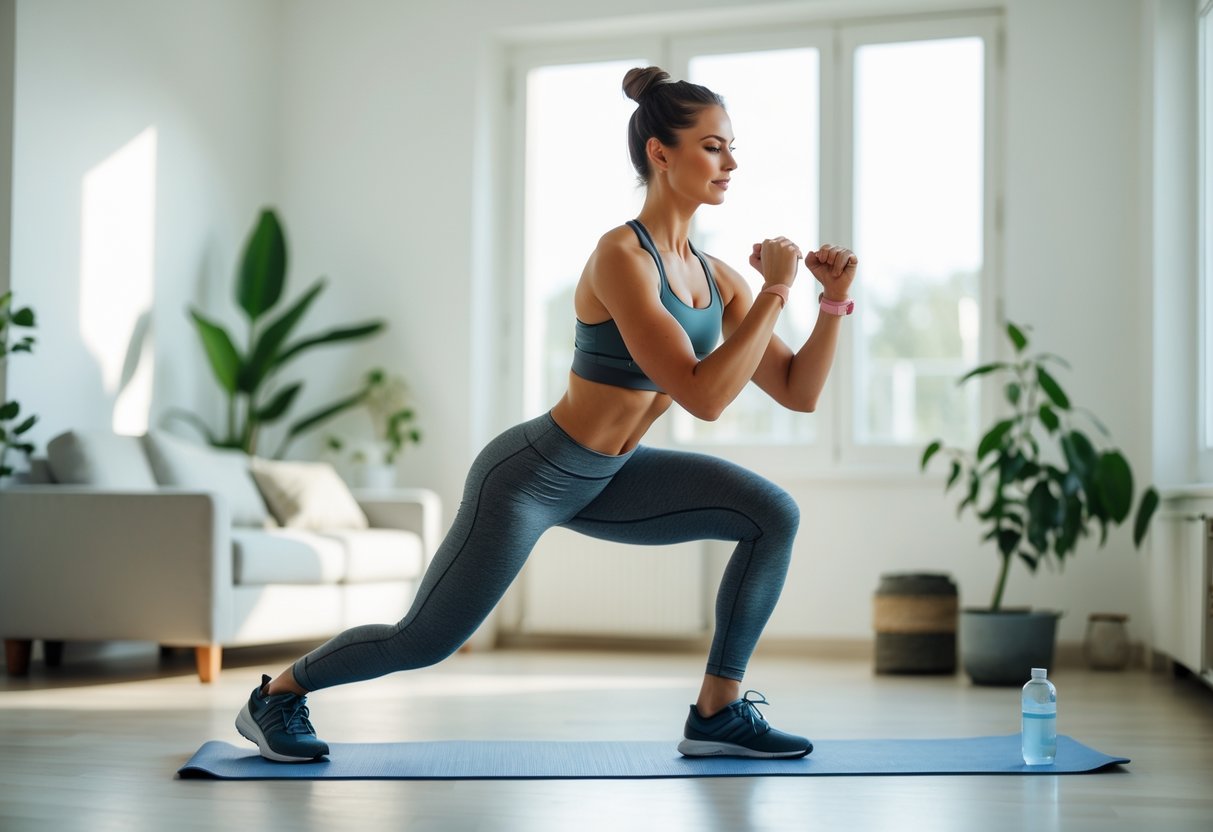
Simple bodyweight exercises done at home can build muscle, burn fat, and boost energy without the need for equipment. Pairing a ketogenic diet with smart workouts may also help speed up fat loss and support a leaner physique.
What are the most effective full-body exercises to do at home without any equipment?
Squats, lunges, push-ups, planks, burpees, and mountain climbers are highly effective. These exercises use major muscle groups and can raise the heart rate.
When performed with good form, they effectively target strength and endurance.
How can females optimize fat burning with at-home exercises?
High-intensity interval training (HIIT) is a good choice because it increases calorie burn in a short time. Including movements like jumping jacks, squat jumps, and quick-paced circuits helps burn more fat.
Consistency and regular challenges to the body also make a difference.
What is a beginner-friendly workout plan that can be done at home to lose weight?
A simple plan might include 20 seconds of work followed by 40 seconds of rest for each exercise: squats, push-ups (on knees if needed), lunges, glute bridges, and plank holds.
Repeat the circuit 2-3 times. Start with 3-4 days per week, and build up as strength improves.
Which exercises should be included in a 7-day workout routine for maximum weight loss for women?
Rotate between squats, lunges, push-ups, planks, burpees, mountain climbers, glute bridges, and jumping jacks. Add in high knees or step-ups for variety.
Mix days of HIIT, strength circuits, and gentle stretching for recovery. Change the order or intensity to keep the body challenged daily.
Can you suggest a daily workout regimen to sculpt and strengthen the body with no equipment?
Alternate upper body, lower body, and core moves through the week. For example, do push-ups and planks on one day; squats and lunges the next; then core work like crunches and bicycle kicks.
Include full-body moves like burpees 2-3 times per week. Each session can last 20-30 minutes.
How can I integrate a ketogenic diet with my at-home workout routine for better fat loss results?
Choose whole-food, low-carb meals focused on non-starchy vegetables, healthy fats, and moderate protein. Plan meals to support energy levels, especially before and after workouts.
Stay hydrated and consider electrolytes. Monitor progress and adjust carbs only if needed to maintain energy for exercise.
Conclusion
Anyone can get stronger and leaner at home by using full body workouts with no equipment.
By relying on bodyweight exercises like squats, push-ups, lunges, and planks, people can build muscle and improve endurance without needing a gym.
These workouts are flexible and easy to fit into any schedule.
A simple 30-minute routine is often enough to target all major muscle groups.
Pairing a regular workout schedule with a keto-friendly meal plan helps support fat loss while maintaining energy.
A low-carb, high-protein diet can make results more noticeable.
Key Points:
- Bodyweight exercises are effective for strength and fat loss
- No equipment saves time and money
- Keto-friendly foods can help with energy and results
Even on busy days, a short workout can have a positive impact.
Listening to the body and making small adjustments can keep the routine safe and enjoyable.
Ready to transform your body without leaving home? Get started today with the Custom Keto Diet—a meal plan built to fuel your workouts and fast-track your results.
